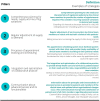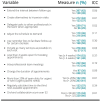Taxonomy of advanced access practice profiles among family physicians, nurse practitioners and nurses in university-affiliated team-based primary healthcare clinics in Quebec
- PMID: 38086598
- PMCID: PMC10729211
- DOI: 10.1136/bmjopen-2023-074681
Taxonomy of advanced access practice profiles among family physicians, nurse practitioners and nurses in university-affiliated team-based primary healthcare clinics in Quebec
Abstract
Objectives: The advanced access model is highly recommended to improve timely access to primary healthcare (PHC). However, its adoption varies among PHC providers. We aim to identify the advanced access profiles of PHC providers.
Design: A cross-sectional study was conducted between October 2019 and March 2020. Latent class analysis (LCA) measures were used to identify PHC provider profiles based on 14 variables, 2 organisational context characteristics (clinical size and geographical area) and 12 advanced access strategies.
Setting and participants: All family physicians, nurse practitioners and nurses working in the 49 university-affiliated team-based PHC clinics in Quebec, Canada, were invited, of which 35 participated.
Primary outcome measure: The LCA was based on 335 respondents. We determined the optimal number of profiles using statistical criteria (Akaike information criterion, Bayesian information criterion) and qualitatively named each of the six advanced access profiles.
Results: (1) Low supply and demand planification (25%) was characterised by the smallest proportion of strategies used to balance supply and demand. (2) Reactive interprofessional collaboration (25%) was characterised by high collaboration and long opening periods for appointment scheduling. (3) Structured interprofessional collaboration (19%) was characterised by high use of interprofessional team meetings. (4) Small urban delegating practices (13%) was exclusively composed of family physicians and characterised by task delegation to other PHC providers on the team. (5) Comprehensive practices in urban settings (13%) was characterised by including as many services as possible on each visit. (6) Rural agility (4%) was characterised by the highest uptake of advanced access strategies based on flexibility, including adjusting the schedule to demand and having a large number of open-slot appointments available in the next 48 hours.
Conclusion: The different patterns of advanced access strategy adoption confirm the need for training to be tailored to individuals, categories of PHC providers and contexts.
Keywords: health services accessibility; organisation of health services; primary health care.
© Author(s) (or their employer(s)) 2023. Re-use permitted under CC BY-NC. No commercial re-use. See rights and permissions. Published by BMJ.
Conflict of interest statement
Competing interests: None declared.
Figures





Similar articles
-
Comparing the implementation of advanced access strategies among primary health care providers.J Interprof Care. 2024 Mar-Apr;38(2):209-219. doi: 10.1080/13561820.2023.2173157. Epub 2023 Feb 10. J Interprof Care. 2024. PMID: 36772809
-
Profiling patterns of patient experiences of access and continuity at team-based primary healthcare clinics (Canada): a latent class analysis.Int J Equity Health. 2024 Oct 17;23(1):213. doi: 10.1186/s12939-024-02300-6. Int J Equity Health. 2024. PMID: 39420365 Free PMC article.
-
Factors associated with patients' experience of access to their multidisciplinary primary health care clinic: A multilevel analysis.Int J Health Plann Manage. 2024 Nov;39(6):1712-1728. doi: 10.1002/hpm.3831. Epub 2024 Jul 28. Int J Health Plann Manage. 2024. PMID: 39073160
-
Barriers and facilitators to the implementation of doctor-nurse substitution strategies in primary care: a qualitative evidence synthesis.Cochrane Database Syst Rev. 2019 Apr 15;4(4):CD010412. doi: 10.1002/14651858.CD010412.pub2. Cochrane Database Syst Rev. 2019. PMID: 30982950 Free PMC article.
-
What improves access to primary healthcare services in rural communities? A systematic review.BMC Prim Care. 2022 Dec 6;23(1):313. doi: 10.1186/s12875-022-01919-0. BMC Prim Care. 2022. PMID: 36474184 Free PMC article.
References
-
- Canadian Institute for Health Information . How Canada compares. Results from the Commonwealth Fund’s 2020 International Health Policy survey of the general population in 11 Countries, Available: https://www.cihi.ca/sites/default/files/document/how-canada-compares-cmw...
-
- Murray M, Tantau C. Same-day appointments: exploding the access paradigm. Fam Pract Manag 2000;7:45–50. - PubMed
Publication types
MeSH terms
LinkOut - more resources
Full Text Sources
Research Materials
